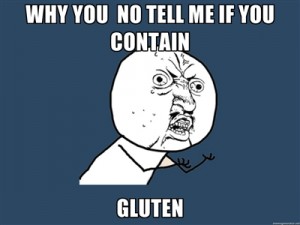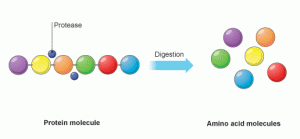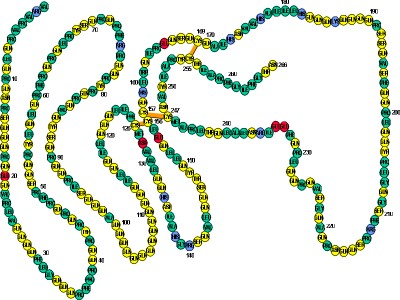
Gluten is evil. There, we said it.
We know “evil” is a strong word, and believe us, we didn’t want gluten to be evil when I started investigating grains. Pasta, bread, and Captain Crunch cereal were a delicious part of my upbringing, but the accumulating evidence linking gluten to a multitude of health problems just cannot be ignored.
Hold on right there, Dr. Gary. You’re always telling us to EAT REAL FOOD, food that comes from nature. Well, gluten comes from nature. It’s a natural protein found in grains, so how can gluten be evil?
Just because something comes from nature doesn’t automatically mean it was intended for human consumption, even if we’ve been consuming it for centuries. While true whole grains are indeed very nutritious, the excessive amounts of gluten we ingest are simply damaging and toxic.
Hidden Sources of Gluten in the SAD
 Interesting initials, don’t you think? SAD stands for the Standard American Diet.
Interesting initials, don’t you think? SAD stands for the Standard American Diet.
The SAD is evil, too. It plays a major role in human illness. The processed, chemical-filled, high-carbohydrate, low-nutrient foods that come in wrappers, bags, and boxes, which most Americans use to feed our families, are killing us slowly from the inside out.
How does gluten fit into our daily lives? If you’ve ever tried to eliminate gluten from your diet, one thing becomes apparent very quickly, and that is that GLUTEN IS IN EVERYTHING!
Not only is gluten found in wheat, barley, rye, and any products made from them, but it’s in almost all processed food and fast food as a thickening agent and emulsifier. You’ll see it on food labels as modified food starch, hydrolyzed protein, and natural flavors, in grain products and others such as sauces, condiments, marinades, processed lunch meat, many cheap nutritional supplements, and even some prescription medications.
If you’re eating a standard American diet, you’re most likely consuming high amounts of gluten. Eventually, the body simply can’t handle it.
Why Grain Anti-Nutrients Are Evil
 Gluten doesn’t want to be eaten. No, I’m not suggesting gluten has a conscious opinion about survival, but survival is an innate drive built into every living organism on a cellular level.
Gluten doesn’t want to be eaten. No, I’m not suggesting gluten has a conscious opinion about survival, but survival is an innate drive built into every living organism on a cellular level.
Humans are at the top of the food chain. We don’t have to worry about being eaten by a lion on the way to work or swallowed by a whale while sunbathing on the patio. Other living entities don’t have that luxury, so they develop natural defenses to increase their chances of living another day.
Porcupines have quills, rhinos have a big pointy horn, pufferfish can swell up inside your stomach and explode you, and grains have anti-nutrients like phytates, lectins, and gluten. These anti-nutrients disrupt the digestive system of animals that eat them, effectively persuading predators to look elsewhere for food.
Grain anti-nutrients are discussed in this article.
As anyone with gluten sensitivity will tell you, the unpleasant effects of gluten can make you never want to eat it again. The bloating, cramping, diarrhea, pain, and other symptoms are immune/inflammatory responses to gluten. We all have it to some degree, but not everyone experiences a noticeable reaction. What’s worse is that gluten sensitivity can lead the way to osteoporosis, irritable bowel disease, cancer, lupus, rheumatoid arthritis, depression, migraines, nerve damage, and a host of other horrible health problems.
Why Gluten Proteins Are Evil
 Ready for more bad news? Gluten destroys the gut.
Ready for more bad news? Gluten destroys the gut.
Gluten is a protein, and proteins are made from strands of amino acids. Picture them like a string of beads, except there are 20 different colors, and the beads can be arranged in varying patterns and lengths. The length and shape of the chain, along with the order of the colors, determine which protein the strand makes.
When a protein is to be digested, enzymes break the strand down into single beads so they can pass through the gut into the bloodstream.
Only these single beads are small enough to get through the gut wall, which ensures that larger particles, bacteria, and viruses stay out.
Once the single beads pass into the bloodstream, the body uses them to reconstruct whatever new proteins it may need at that time. But here is the problem:
First, gluten grains contain “protease inhibitors,” which stop the body from making the enzymes necessary to break proteins apart (pretty sneaky, no?). Second, our bodies don’t even possess the capability of breaking gluten down completely into single amino acids. They remain as “peptides,” which are short amino acid chains. Our inability to digest gluten can ultimately destroy our intestinal flora and damage the gut lining itself.
Why Gliadin in Gluten is Evil
 Gluten is a protein comprised of other proteins, one of which is gliadin (left).
Gluten is a protein comprised of other proteins, one of which is gliadin (left).
Gliadin has shown a particular aptitude for permeating the gut wall and passing into the bloodstream.
It accomplishes this in a number of ways.
- Grain anti-nutrients damage the small intestine to the extent that gliadin (and other undigested grain proteins and gut particles) can pass through.
- Phytates in grains attach to minerals like iron, magnesium, calcium, and zinc in the small intestine and inhibit the body’s ability to absorb them. This is one reason why Celiac patients are often also anemic. The body responds to this iron deficiency by increasing the number of cells that transport iron across the gut barrier. Gliadin cunningly hops onto these carrier cells and rides them into the bloodstream.
- The gut wall is virtually impenetrable. It has to be in order to keep bacteria and viruses from causing problems. However, if bad bacteria are threatening gut health, gut cells release a chemical called zonulin to loosen the barrier and let the bacteria/viruses into the body, where immune cells can kill them. Since the body sees gliadin as a threat, zonulin opens the door for gliadin to pass.
Once in the bloodstream, grain proteins are disastrous. Immune cells know gliadin, and its buddies are trespassing and tag them for destruction. The immune system then creates an army of antibodies to hunt down and neutralize gliadin or whatever grain proteins have advanced through the gut wall.
 In our previous article on low thyroid hormone, we explained that the molecular structures of both gliadin and thyroid tissue are very similar, and therefore the immune system sometimes mistakenly attacks the thyroid, thinking it’s gliadin.
In our previous article on low thyroid hormone, we explained that the molecular structures of both gliadin and thyroid tissue are very similar, and therefore the immune system sometimes mistakenly attacks the thyroid, thinking it’s gliadin.
Any grain protein that resembles organ tissue or other invaders (bacteria and viruses) can cause the body to attack itself. If the assault is on pancreatic cells, you have type 1 diabetes. If on synovial tissue, you have rheumatoid arthritis. If on nerve cells, you have multiple sclerosis, and so on.
This is an autoimmune disease, and when I hear about the body attacking its own tissue, grains are always the first thing that comes to mind.
For anyone who is suffering from gluten-related health issues, it’s not enough to simply eliminate gluten from your diet. There are grocery store shelves full of processed junk labeled “gluten-free” that will still sledgehammer your health into the pavement. Grains must be eliminated completely, and a nutrient-dense, whole-food diet with lots of raw fruits and vegetables, along with a dairy-free probiotic, is essential.
We also review Gluten-Free products designed specifically to compliment a gluten-free diet.

Gary has many years experience as a healthcare writer covering different types of medicine. His work is published by many different companies including the American College of Allergy, Asthma & Immunology (ACA).

